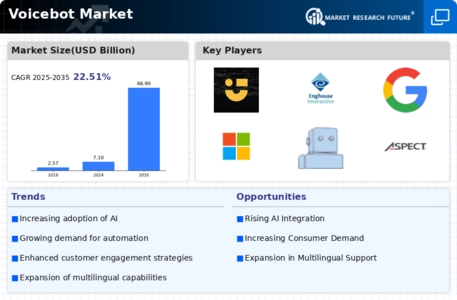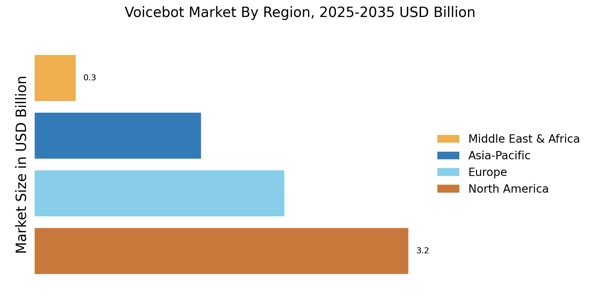Rising Consumer Expectations
In the Voicebot Market, rising consumer expectations play a pivotal role in shaping market dynamics. Customers increasingly demand quick, accurate, and personalized responses from businesses. This shift in consumer behavior compels organizations to adopt voicebot technology to meet these expectations. Data indicates that 70% of consumers prefer interacting with voicebots for simple inquiries, as they provide immediate assistance without the need for human intervention. Consequently, businesses are investing in advanced voicebot solutions to enhance customer satisfaction and loyalty. The Voicebot Market is thus experiencing growth as companies recognize the necessity of adapting to evolving consumer preferences, ensuring that they remain competitive in an increasingly digital landscape.
Growing Demand for Automation
The Voicebot Market experiences a notable surge in demand for automation across various sectors. Businesses increasingly seek to enhance operational efficiency and reduce costs, leading to a greater reliance on voicebots for customer interactions. According to recent data, the automation of customer service processes through voicebots can reduce operational costs by up to 30%. This trend is particularly evident in industries such as retail and telecommunications, where companies are integrating voicebots to handle routine inquiries and transactions. As organizations strive to streamline their operations, the Voicebot Market is poised for substantial growth, driven by the need for efficient, automated solutions that can handle high volumes of customer interactions without compromising service quality.
Technological Advancements in AI
Technological advancements in artificial intelligence (AI) significantly influence the Voicebot Market. Innovations in machine learning and natural language processing enable voicebots to understand and respond to human language with greater accuracy and context. As AI technology continues to evolve, voicebots are becoming more sophisticated, capable of handling complex queries and providing personalized experiences. Recent studies suggest that the AI-driven voicebot market is expected to grow at a compound annual growth rate of over 30% in the coming years. This rapid advancement in AI technology not only enhances the functionality of voicebots but also expands their applicability across various sectors, including healthcare, finance, and entertainment, thereby driving the Voicebot Market forward.
Integration with Omnichannel Strategies
The integration of voicebots into omnichannel strategies is a significant driver for the Voicebot Market. Businesses are increasingly recognizing the importance of providing a seamless customer experience across multiple channels, including voice, chat, and social media. By incorporating voicebots into their omnichannel frameworks, organizations can ensure consistent messaging and support, regardless of the platform. This integration allows for a more cohesive customer journey, which is essential in retaining customer loyalty. Data shows that companies employing omnichannel strategies can achieve a 91% higher year-over-year customer retention rate. As a result, the Voicebot Market is likely to see continued growth as businesses strive to enhance their omnichannel capabilities through effective voicebot solutions.
Cost-Effectiveness of Voicebot Solutions
The cost-effectiveness of voicebot solutions serves as a compelling driver for the Voicebot Market. Organizations are increasingly aware of the financial benefits associated with deploying voicebots for customer service and support. By automating routine tasks, businesses can significantly reduce labor costs while maintaining high levels of service. Research indicates that companies can save up to 50% on customer service costs by implementing voicebot technology. This financial incentive encourages more businesses to invest in voicebot solutions, thereby expanding the market. As the demand for cost-effective customer service solutions continues to rise, the Voicebot Market is expected to flourish, attracting a diverse range of industries seeking to optimize their operational expenditures.


















Leave a Comment